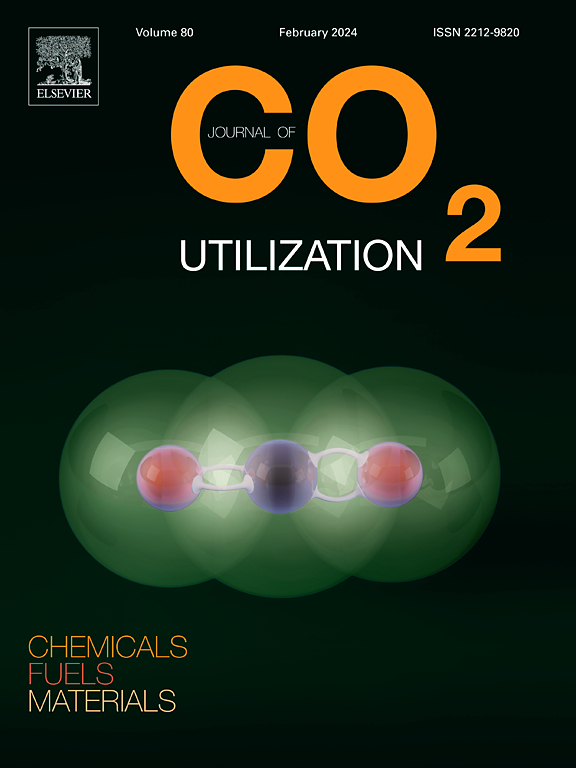Formation of bio-based cyclic carbonates from CO2 and renewable feedstocks via porous poly(azomethine) -based heterogeneous catalysts approach
IF 7.2
2区 工程技术
Q1 CHEMISTRY, MULTIDISCIPLINARY
引用次数: 0
Abstract
Two families of heterogeneous porous catalysts based on iron or cobalt poly(azomethine) (PAM) networks were reported to synthesize cyclic carbonates from bio-based aliphatic oxides epoxides and carbon dioxide (CO2). The different PAM supports were prepared by reacting 2,6-pyridine dicarboxaldehyde with 1,3,5 tris(4 aminophenyl)benzene (PAM-1) or with melamine (PAM-2) by microwave activation. Both supports exhibited high thermal stability and similar CO2 uptake (1.3 mmol/g) but PAM-2 showed higher specific surface area (779 m2/g vs 401 m2/g), more crystallinity and less capacity for anchoring metals than PAM-1. The novel catalysts were used in the cycloaddition of CO2 to renewable feedstocks. Thus, using epoxidized methyl oleate (MOE) the corresponding cyclic carbonates were obtained with excellent yields (78–96 %) using a CO2 pressure of 7 bars, 120 ºC and 16 h of reaction. The best catalysts of the series, Fe@PAMs were also evaluated in the cycloaddition of CO2 to epoxidized soybean oil (ESBO) in the same condition reaction obtaining excellent performance, epoxide conversions and cyclic carbonate yields greater than 90 %.
通过多孔聚(偶氮甲基)基异相催化剂方法从二氧化碳和可再生原料中生成生物基环碳酸盐
据报道,基于铁或钴聚(偶氮亚甲基)(PAM)网络的两类异相多孔催化剂可从生物基脂肪族氧化物环氧化物和二氧化碳(CO2)中合成环碳酸盐。2,6 吡啶二甲醛与 1,3,5 三(4 氨基苯基)苯(PAM-1)或三聚氰胺(PAM-2)通过微波活化反应制备了不同的 PAM 支持物。两种载体都具有较高的热稳定性和相似的二氧化碳吸收量(1.3 mmol/g),但 PAM-2 比 PAM-1 的比表面积更高(779 m2/g 对 401 m2/g),结晶度更高,锚定金属的能力更弱。新型催化剂被用于 CO2 与可再生原料的环加成反应。因此,使用环氧化油酸甲酯 (MOE),在二氧化碳压力为 7 巴、温度为 120 ºC 和反应时间为 16 小时的条件下,可以获得相应的环碳酸盐,且收率极高(78-96%)。该系列的最佳催化剂 Fe@PAMs 还在 CO2 与环氧化大豆油 (ESBO) 的环加成反应中进行了评估,在相同条件下,该催化剂的性能优异,环氧化物转化率和环碳酸盐产率均超过 90%。
本文章由计算机程序翻译,如有差异,请以英文原文为准。
求助全文
约1分钟内获得全文
求助全文
来源期刊

Journal of CO2 Utilization
CHEMISTRY, MULTIDISCIPLINARY-ENGINEERING, CHEMICAL
CiteScore
13.90
自引率
10.40%
发文量
406
审稿时长
2.8 months
期刊介绍:
The Journal of CO2 Utilization offers a single, multi-disciplinary, scholarly platform for the exchange of novel research in the field of CO2 re-use for scientists and engineers in chemicals, fuels and materials.
The emphasis is on the dissemination of leading-edge research from basic science to the development of new processes, technologies and applications.
The Journal of CO2 Utilization publishes original peer-reviewed research papers, reviews, and short communications, including experimental and theoretical work, and analytical models and simulations.
 求助内容:
求助内容: 应助结果提醒方式:
应助结果提醒方式:


